Why Rigatoni Is the Ultimate Pasta for Sauce Lovers
Rigatoni is a large, ridged tube pasta that originated in southern Italy and has become one of the most beloved pasta shapes worldwide. Its distinctive ridges and wide hollow center make it perfect for capturing and holding chunky sauces, creamy preparations, and melted cheese.
Quick Rigatoni Facts:
- Shape: Large ridged tubes with straight-cut ends
- Size: Larger than penne and ziti
- Origin: Southern and central Italy, especially popular in Sicily
- Best for: Hearty meat sauces, baked dishes, creamy sauces
- Cook time: 12-13 minutes to al dente
- Serving size: 4 oz per person for main dish, 2 oz with sides
The name “rigatoni” comes from the Italian word rigato, meaning “ridged” or “lined.” These ridges aren’t just for looks – they create the perfect texture for sauce to cling to both inside and outside the pasta tube.
For avid foodie travelers seeking authentic Italian culinary experiences, understanding rigatoni opens doors to countless regional specialties. From Rome’s traditional rigatoni con la pajata to Sicily’s seafood-studded variations, this pasta shape tells the story of Italy’s diverse food culture.
What makes rigatoni special is its functionality. The large diameter holds chunky ingredients like Italian sausage and vegetables, while the ridged exterior grips smooth sauces like vodka or cream-based preparations. This dual-action sauce retention is why rigatoni appears on menus at top trattorias across Italy and in New York City’s finest Italian restaurants.
As sustainable dining trends continue to grow, choosing quality artisanal rigatoni made with traditional bronze-die methods supports small Italian producers who’ve perfected their craft over generations.
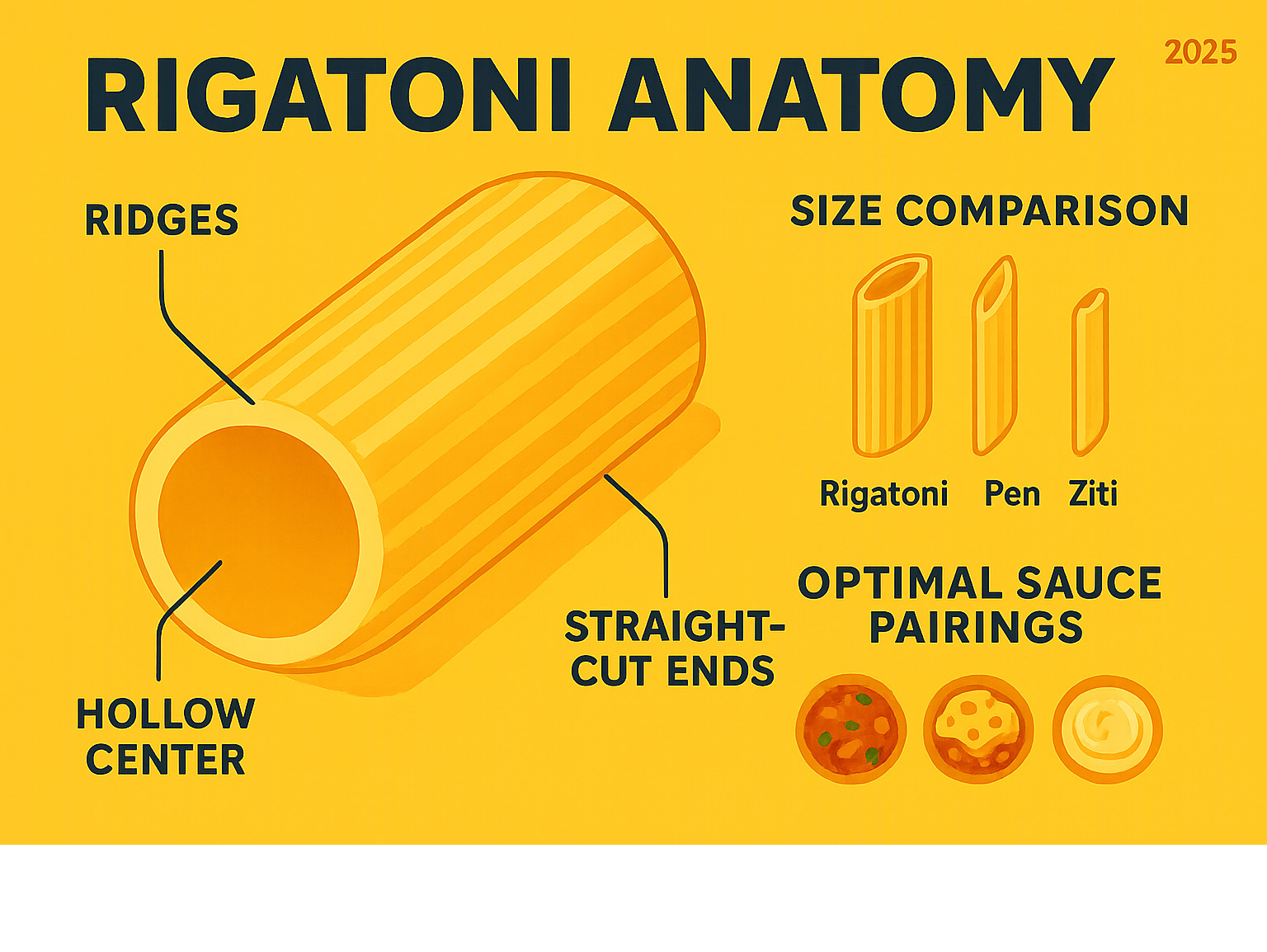
Relevant articles related to rigatoni:
Why This Guide Matters
As culinary tourism continues to flourish, pasta knowledge has become essential for any serious food traveler. When we explore Italian restaurants in New York City or plan a culinary trip to Italy, understanding the nuances of pasta shapes like rigatoni improves our dining experiences immeasurably.
This comprehensive guide serves food enthusiasts who want to cook like Italian nonnas at home and travelers seeking authentic pasta experiences abroad. Whether you’re ordering at a Roman trattoria or shopping for quality pasta in specialty stores, this knowledge transforms you from a casual diner into an informed culinary traveler.
Focus Keyphrase
Throughout this guide, we’ll explore rigatoni pasta in all its glory – from its ancient origins to modern cooking techniques that will lift your home kitchen game.
Rigatoni 101: Shape, Size & Comparisons
When you pick up a piece of rigatoni, you’re holding pasta perfection in your hands. This isn’t just another tube-shaped noodle – it’s a carefully engineered sauce delivery system that Italian pasta makers have been perfecting for generations.
Defining Characteristics of Rigatoni
What makes rigatoni so special? It all comes down to its brilliant design. The name itself gives us the first clue – “rigatoni” comes from the Italian word rigato, meaning “ridged” or “lined.”
Those ridges running along the outside aren’t just for show. They create tiny channels that grab onto sauce like a delicious hug. Whether you’re twirling creamy vodka sauce or chunky meat ragù, those ridges make sure every drop stays where it belongs – on your pasta, not sliding off onto the plate.
The wide hollow center is equally important. At about half an inch in diameter, rigatoni’s tube is spacious enough to hold diced vegetables, crumbled sausage, or melted cheese. It’s like having a little edible pocket in every bite.
Unlike penne with its slanted cuts, rigatoni features straight-cut ends that create perfect circular openings. This design maximizes the pasta’s ability to scoop up sauce and ingredients from your bowl.
Rigatoni vs Penne vs Ziti
Here’s where things get interesting. While all three are tube pastas, they each have their own personality:
| Feature | Rigatoni | Penne | Ziti |
|---|---|---|---|
| Size | Large (1.5″ long) | Medium (1.25″ long) | Medium (1″ long) |
| End Cut | Straight/perpendicular | Diagonal | Straight |
| Ridges | Prominent ridges | Ridged exterior | Smooth or lightly ridged |
| Sauce Capacity | High (inside + outside) | Medium | Medium |
| Best Uses | Baked dishes, chunky sauces | Light sauces, salads | Baked dishes, simple sauces |
| Cook Time | 12-13 minutes | 10-12 minutes | 11-13 minutes |
Rigatoni is the heavyweight champion of sauce retention. Its larger size and prominent ridges mean it can handle the heartiest, chunkiest sauces without breaking a sweat. When you’re making a robust Bolognese or a cream sauce loaded with vegetables, rigatoni rises to the occasion.
Penne’s diagonal cuts create pointed ends that work beautifully with lighter preparations. Those angled edges help the pasta move gracefully through delicate sauces without overwhelming them.
Ziti’s smooth surface makes it the minimalist of the trio. It’s perfect when you want the sauce to be the star, providing a neutral canvas for simple tomato-based dishes.
Mini & Maxi Versions: Rigatoncini and Mezze Maniche
The rigatoni family has some charming relatives worth knowing about. Rigatoncini – the “little rigatoni” – measures about an inch long and brings all the sauce-gripping power of its bigger sibling in a more delicate package. It’s particularly beloved in Sicily, where it pairs beautifully with seafood dishes.
Mezze maniche, meaning “half sleeves,” splits the difference between standard rigatoni and rigatoncini. It maintains those essential ridges and the wide opening but in a more compact form that works wonderfully in pasta salads or with lighter sauces.
When it comes to portion guidance, standard rigatoni needs about 4 ounces per person for main courses. Rigatoncini is surprisingly filling despite its smaller size, so 3.5 ounces usually does the trick. Mezze maniche follows the standard 4-ounce rule.
Origins & Production: From Ancient Rome to Modern Bronze Dies
The story of rigatoni stretches back centuries through the sun-drenched regions of southern and central Italy, where resourceful cooks found that ridged pasta tubes could transform simple ingredients into extraordinary meals.
Historical Highlights
Rigatoni found its home in the busy kitchens of Rome and Sicily, where the pasta’s name emerged from the Italian word rigato, meaning “ridged” or “lined.” Those distinctive grooves weren’t just decorative – they were culinary genius in pasta form.
In Roman trattorias, rigatoni became the star of cucina povera – the ingenious cooking style of families who knew how to make magic with modest ingredients. The famous rigatoni con la pajata, made with calf intestines still containing milk, showed how Italian cooks could lift humble components into beloved comfort food.
Sicily acceptd rigatoni with particular passion. The island’s abundant seafood found a perfect partner in rigatoni’s ridged tubes and hollow centers, which captured every drop of complex fish stews and seafood ragùs.
How Rigatoni Is Made
Creating quality rigatoni requires patience, precision, and respect for tradition. Scientific research on pasta quality confirms what Italian pasta makers have known for generations – the old ways really do produce superior results.
The foundation starts with durum wheat semolina and water – that’s it. The best producers source high-protein durum wheat that’s been naturally dried under Mediterranean sun, avoiding any chemical treatments or industrial shortcuts that compromise flavor and nutrition.
The magic happens during extrusion, where semolina dough gets pressed through bronze dies to create rigatoni’s signature shape. Those ridges can’t be formed by hand – they need the mechanical precision of bronze die extrusion, which creates the pasta’s wonderfully porous surface texture that sauce lovers adore.
Slow drying separates exceptional rigatoni from ordinary pasta. Artisanal producers dry their pasta at gentle temperatures below 104°F for 12 to 20 hours. This patient process preserves valuable nutrients like polyphenols, vitamins, and dietary fiber that would be destroyed by high-heat industrial methods.
Artisanal vs Mass-Produced Rigatoni
Once you’ve tasted truly artisanal rigatoni, there’s no going back to the mass-produced stuff. The difference hits you immediately – it’s like comparing a hand-knitted sweater to something from a factory line.
Bronze dies create the rough, porous surface that makes sauce cling like it’s meant to be there. Mass-produced pasta extruded through Teflon dies comes out smooth and shiny – pretty to look at, but sauce just slides right off instead of creating that perfect marriage of pasta and flavor.
The drying temperature tells the whole story. Artisanal producers take their time at around 86°F, while industrial operations crank up the heat to 176°F to speed things along. Those higher temperatures trigger chemical reactions that create off-flavors and destroy the good stuff your body actually wants.
When you’re shopping for quality rigatoni, look for pasta with a pale, matte appearance rather than glossy shine, packaging that mentions bronze die extrusion and slow drying at low temperatures, and durum wheat semolina from specific Italian regions. Quality production costs more, so expect to pay a premium for pasta that’s been crafted with care and tradition.
Cooking Rigatoni Like a Chef
Mastering rigatoni cookery transforms this humble pasta into restaurant-quality dishes that showcase its unique sauce-holding capabilities.
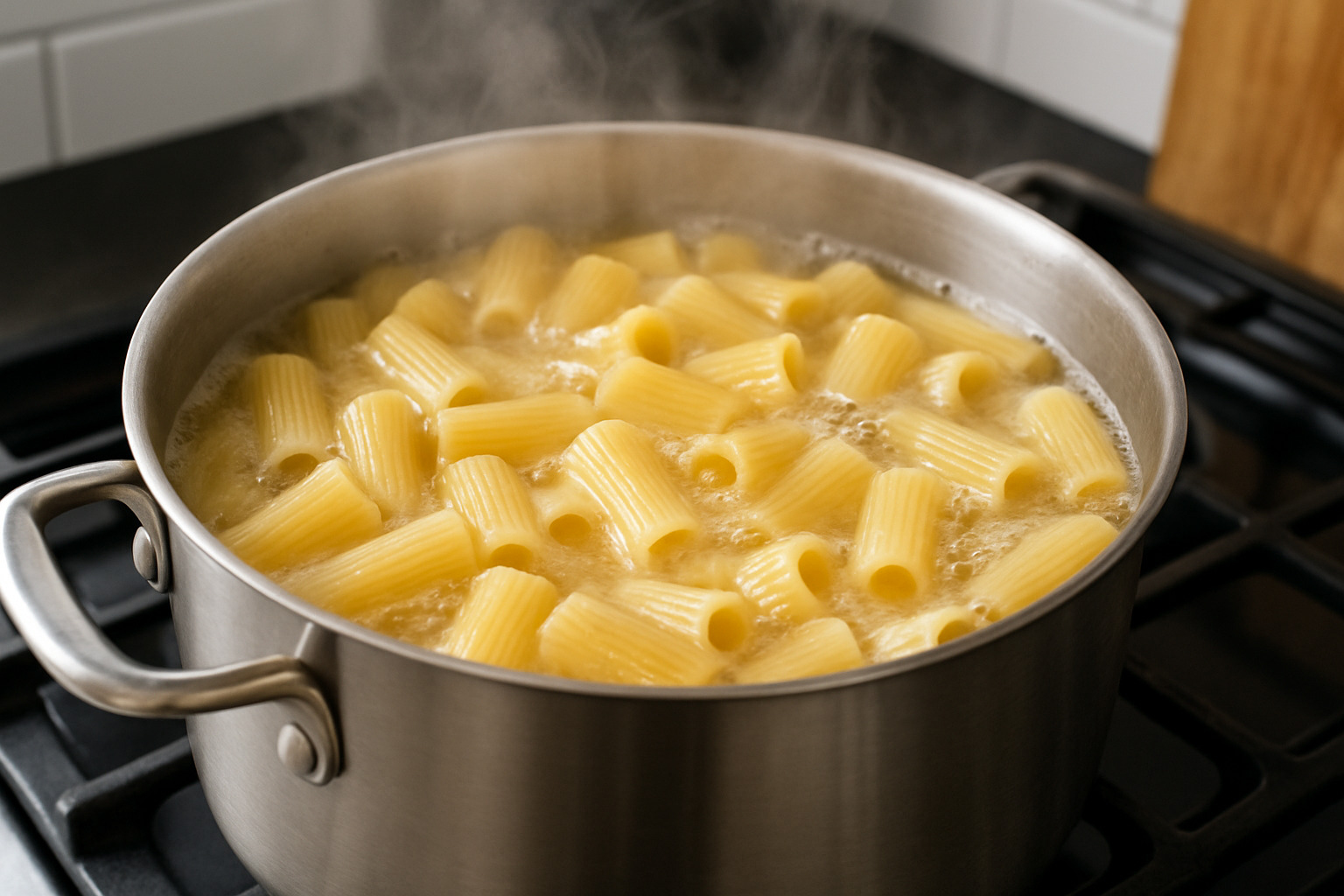
The secret to perfect rigatoni lies in understanding that those beautiful ridges and hollow centers need proper technique to shine. Too many home cooks rush the process, but cooking rigatoni like the pros requires patience and attention to detail.
Step-by-Step: Stove-Top Rigatoni
Getting your water right is the foundation of great pasta. Fill a large pot with at least 4 quarts of water for every pound of rigatoni – this gives the pasta room to move freely without sticking together. Salt that water generously until it tastes like the ocean. This is your only chance to season the pasta itself, so don’t be shy.
When the water reaches a rolling boil, add your rigatoni and give it an immediate stir. This prevents those tubes from clumping together in the first crucial minutes. Here’s where timing becomes everything: cook for 1 minute less than the package directions suggest. Most rigatoni needs about 11-12 minutes total, so we’re looking at 10-11 minutes in the pot.
Before you drain that pasta, save a full cup of the cooking water. This starchy, salty liquid is pure gold for creating silky sauces. Never rinse your rigatoni after draining – you want that slightly sticky surface to help your sauce cling.
The risottare method is where home cooks can really lift their game. Transfer your slightly undercooked rigatoni directly into the pan with your sauce, add a splash of that reserved pasta water, and cook everything together for 1-2 minutes. This technique lets the pasta absorb the sauce flavors while the starches help bind everything into a cohesive dish.
Baked Rigatoni Techniques
Baked rigatoni showcases this pasta’s incredible structural strength – those thick walls hold up beautifully even after extended oven time. The key is proper layering, similar to techniques used in Manicotti preparation.
Start by cooking your rigatoni 2-3 minutes less than al dente since it will finish cooking in the oven. Toss the warm pasta with your sauce immediately – this ensures every ridge and hollow gets coated properly.
Layer your sauced rigatoni in a buttered baking dish, adding cheese between layers for maximum melty goodness. Cover with foil for the first 25 minutes to prevent the top from drying out, then remove it for the final 10-15 minutes to achieve that beautiful golden browning.
The cheese strategy makes all the difference here. Combine ricotta for creaminess, mozzarella for that satisfying cheese pull, and Parmigiano-Reggiano for sharp, nutty depth. This trio creates layers of flavor that complement rigatoni’s hearty texture perfectly.
Pro Tips for Perfect Rigatoni
A splash of heavy cream added at the very end of cooking creates restaurant-level sauce texture. The cream doesn’t just add richness – it acts as a binding agent that helps sauce cling to every ridge while creating that glossy finish that makes dishes look professionally prepared.
Portion planning is crucial for rigatoni’s substantial size. Plan on 4 ounces of dried rigatoni per person for main courses, or scale back to 2 ounces when you’re serving hearty sides. One pound typically feeds 4-6 people, depending on appetites and what else is on the table.
For baked dishes, let your rigatoni rest for 5-10 minutes after it comes out of the oven. This brief pause allows the cheese to set slightly, preventing a molten mess when you serve. Your guests will thank you for portions that hold their shape on the plate.
The magic of perfectly cooked rigatoni lies in respecting its architecture – those ridges and tubes aren’t just decorative. They’re designed to capture and hold flavors, creating a pasta experience that’s both satisfying and sophisticated.
Sauces, Recipes & Perfect Pairings
The magic of rigatoni truly shines when paired with the right sauces and ingredients. Think of each tube as a tiny flavor vessel, designed by Italian ingenuity to capture and deliver maximum taste in every single bite.
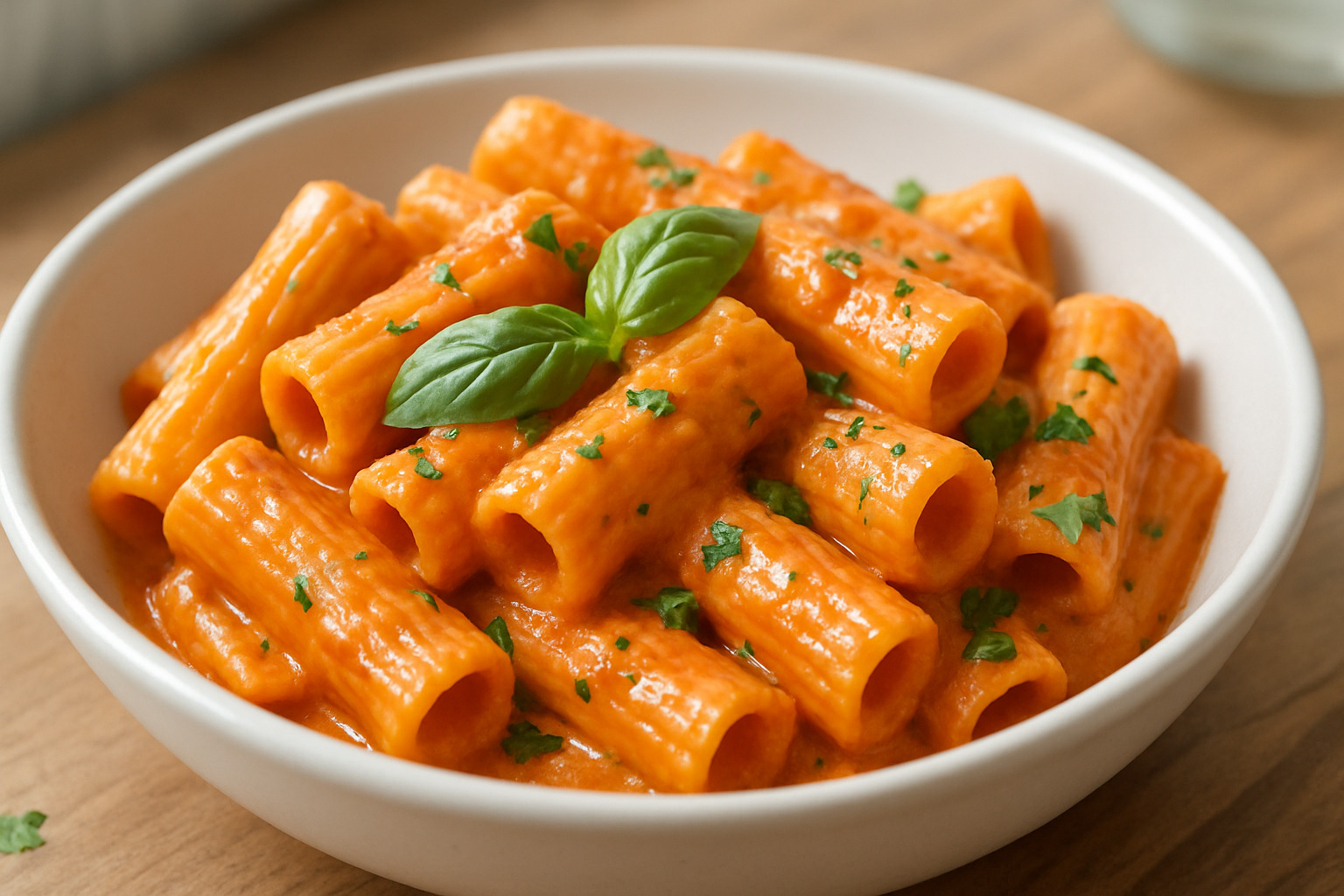
Best Sauces for Rigatoni
When it comes to ragù Bolognese, rigatoni pasta becomes pure poetry. The wide tubes accept chunks of slowly braised beef and pork, while those signature ridges grip every drop of the rich, wine-kissed sauce. A proper Bolognese contains more meat than tomatoes, building its soul on that sacred Italian foundation of finely diced onion, carrot, and celery – what Italians lovingly call the “soffritto.”
Vodka Sauce transforms rigatoni into something absolutely luxurious. The creamy tomato base doesn’t just coat the pasta – it clings to every ridge like silk. The vodka isn’t just for show; it acts as a culinary matchmaker, helping the cream and tomatoes fall in love and create that signature pink perfection.
While pesto traditionally dances with delicate angel hair, it creates something wonderfully rustic when paired with rigatoni. The basil-rich sauce settles into those ridges while pine nuts and cheese chunks find cozy homes inside the hollow centers. It’s comfort food with an neat twist.
Along Italy’s stunning coastlines, seafood sauces have found their perfect partner in rigatoni. The pasta’s sturdy build stands up beautifully to chunky fish stews, while its textured surface captures every drop of those complex, tomato-kissed seafood broths.
Classic Recipes Featuring Rigatoni
Rigatoni al Segreto carries the mystique of New York City’s finest Italian kitchens. This “secret sauce” recipe builds its magic on a tomato base enriched with an almost scandalous amount of butter and aged Parmigiano-Reggiano. The secret? Using far more butter than any reasonable person would expect – creating a glossy, restaurant-quality finish that makes every bite unforgettable.
Baked rigatoni with Italian sausage represents comfort food at its absolute finest. Picture rigatoni tubes cradling crumbled sausage, swimming in rich marinara, and blanketed with melted cheese. The trick lies in being generous with the sauce – pasta absorbs moisture as it bakes, and nobody wants a disappointing dry casserole.
For autumn inspiration, Rigatoni With Sweet Turkey Sausage and Creamy Pumpkin Sauce showcases how rigatoni’s hollow architecture becomes a canvas for seasonal flavors. Diced pumpkin and turkey sausage pieces nestle inside each tube, creating little surprise packages of fall comfort.
Ingredient Matchmaking
The romance between rigatoni and Italian sausage runs deep in Italian-American tradition. Those perfectly sized sausage pieces slip right inside the pasta tubes, while the rendered fat enriches whatever sauce joins the party. It’s a match made in culinary heaven.
Mascarpone lifts rigatoni pasta to pure luxury. Unlike regular cream cheese, this Italian treasure never curdles when heated, making it perfect for creating those silky, restaurant-quality sauces that coat every ridge and fill every hollow.
Chunky vegetables like diced eggplant, bell peppers, and zucchini find their perfect home with rigatoni. These vegetables actually fit inside the pasta tubes, creating delightful flavor surprises that make every bite an trip.
The art of cheese combinations reaches its peak with rigatoni. Creamy ricotta provides the foundation, sharp aged Parmigiano-Reggiano adds complexity, and fresh mozzarella – always shredded from a block, never pre-shredded – delivers that Instagram-worthy cheese pull that makes hearts skip beats.
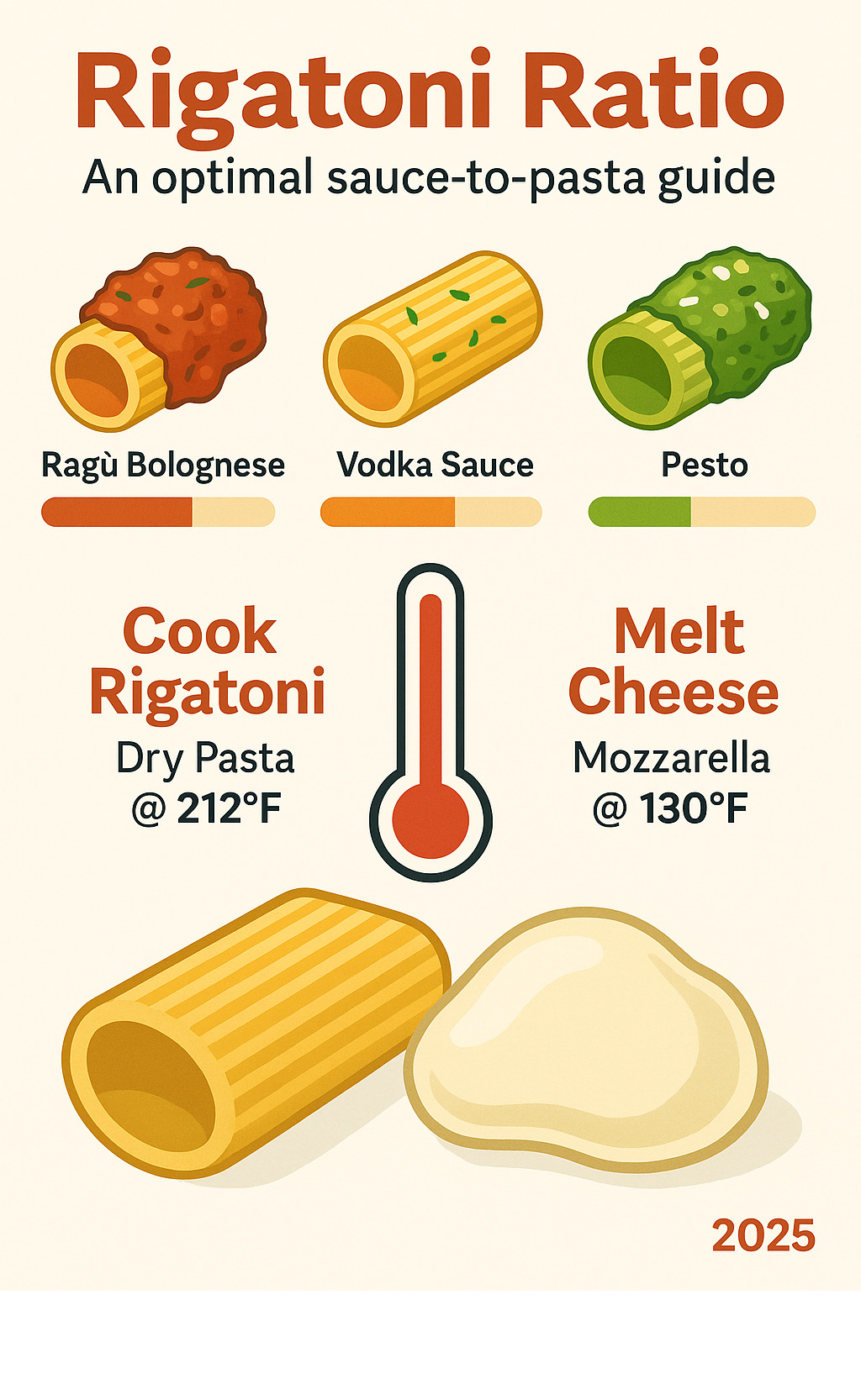
Buying, Storing, Variations & FAQs
Shopping for rigatoni can feel overwhelming when you’re staring at dozens of pasta boxes in the store. But once you know what to look for, finding quality pasta becomes second nature – and your taste buds will thank you for the effort.
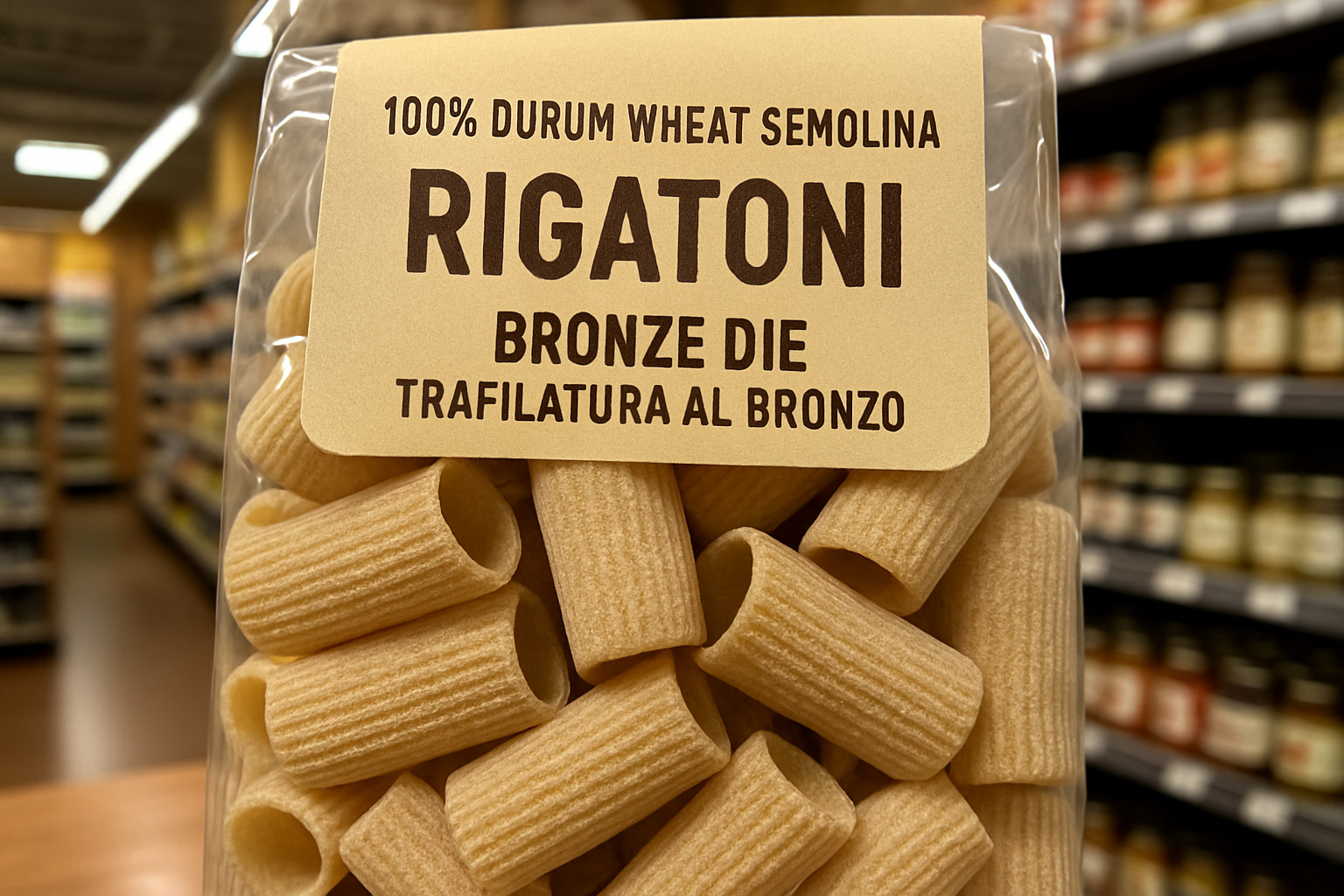
How to Choose Quality Rigatoni
The secret to great rigatoni starts with durum wheat semolina. Look for packages that say “100% durum wheat semolina” – this hard wheat variety packs more protein (usually 12-15%) than regular wheat, which means your pasta holds its shape beautifully during cooking instead of turning mushy.
Bronze die extrusion is your golden ticket to superior sauce-gripping pasta. Quality rigatoni has a rough, matte surface that looks almost chalky compared to the shiny, smooth appearance of mass-produced versions. The package should proudly display “bronze die” or “trafilatura al bronzo” if it’s imported from Italy.
Slow-dry labels matter enormously. Artisanal producers dry their pasta at temperatures between 30-40°C over many hours, preserving nutrients and creating better texture. Industrial pasta gets blasted with high heat to speed production, which destroys vitamins and creates inferior taste.
Price tells a story too. Quality rigatoni typically costs above $3.50 per box because good ingredients, traditional bronze dies, and slow drying processes cost more. When pasta is suspiciously cheap, corners have been cut somewhere in production.
Storage & Reheating
Storing rigatoni properly keeps it fresh and prevents pantry disasters. Unopened packages stay good for a full year in a cool, dry spot. Once opened, transfer the pasta to airtight containers.
Cooked rigatoni keeps in the refrigerator for up to four days when stored in sealed containers. The trick is to slightly undercook it initially since it continues softening during storage.
Freezing works beautifully for sauced rigatoni dishes. They keep for up to six months when frozen in portion-sized containers. Pasta with sauce freezes much better than plain pasta, which tends to get mushy when thawed.
When it’s time to reheat, choose your method based on the dish. Baked rigatoni dishes reheat best in the oven covered with foil at 375°F. For stovetop reheating, add a splash of water or broth and heat gently in a covered pan.
Notable Variations of Rigatoni
The rigatoni family includes some delightful cousins worth getting to know. Rigatoncini are the “little rigatoni” – about an inch long instead of the standard 1.5 inches. They’re particularly popular in Sicily, where they work beautifully with delicate seafood dishes.
Mezze maniche translates to “half sleeves” and describes rigatoni that’s been shortened while keeping the same width and ridged texture. Think of it as rigatoni pasta’s more manageable little brother – perfect for pasta salads or when you want the characteristic ridges without committing to the full-size tubes.
Gluten-free rigatoni has come a long way in recent years. Modern versions made from rice, corn, or legume flours can approximate the original’s texture, though they typically don’t hold sauce quite as well.
Whole wheat rigatoni offers more fiber and nutrients while keeping the beloved shape. The nuttier flavor pairs especially well with robust meat sauces and hearty vegetable preparations.
Frequently Asked Questions about Rigatoni
How much rigatoni should I cook per person? Plan for 4 ounces of dried rigatoni per person when it’s the main event, or 2 ounces when you’re serving it alongside other substantial dishes. One pound typically feeds 4-6 people.
Why do the ridges matter so much? Those ridges aren’t just decorative – they’re functional genius. The ridged surface creates multiple areas for sauce to grab onto, essentially tripling the pasta’s sauce-holding power compared to smooth tubes.
Can I substitute other pasta shapes for rigatoni? Penne, ziti, or tortiglioni can work in most recipes, though you’ll lose some of that superior sauce-holding ability that makes rigatoni special.
What’s the best way to prevent rigatoni from sticking together? Use plenty of generously salted water – at least 4 quarts for a pound of pasta. Stir immediately after adding the rigatoni to the pot, and don’t overcrowd.
Are there traditional rigatoni dishes I should try? Absolutely! If you’re ever in Rome, seek out rigatoni con la pajata. Sicilian-style rigatoni with seafood showcases the pasta’s versatility, while mastering rigatoni al segreto with its luxurious butter-rich tomato sauce will make you feel like a true Italian cook.
Conclusion
Rigatoni has earned its place as the ultimate sauce-gripping superstar of the pasta world, and now you understand exactly why. From its humble beginnings in the trattorias of southern Italy to your own kitchen table, this ridged tube pasta continues to bring families and friends together over memorable meals.
The beauty of rigatoni pasta lies in its perfect engineering – those signature ridges and generous hollow center aren’t accidents of design. They’re the result of centuries of Italian culinary wisdom, creating a pasta shape that transforms simple ingredients into extraordinary dishes. Whether you’re tossing it with a quick weeknight sauce or layering it into an elaborate Sunday casserole, rigatoni delivers flavor in every single bite.
Your culinary trips don’t have to stop at your local grocery store. When you’re exploring New York City’s vibrant Italian dining scene or planning your next global culinary tours, you’ll now recognize quality rigatoni on menus and understand why certain dishes work so beautifully with this particular pasta shape.
We’re living in exciting times for food lovers who care about quality and sustainability. By choosing artisanal rigatoni made with traditional bronze dies and slow-drying methods, you’re supporting the small Italian producers who’ve perfected their craft over generations. This aligns perfectly with the growing sustainable dining trends that are reshaping how we think about food.
At The Dining Destination, we believe that understanding ingredients like rigatoni makes every meal more meaningful. It’s the difference between simply eating pasta and truly experiencing the rich culinary heritage that connects us to generations of Italian cooks who knew that the right pasta shape could turn ordinary ingredients into something magical.
The next time you’re standing in the pasta aisle or reading a menu at your favorite Italian restaurant, you’ll see rigatoni with new eyes. Those ridges aren’t just pretty – they’re functional features designed to capture every drop of sauce and hold every piece of ingredient. That’s the kind of culinary knowledge that transforms good home cooks into confident ones, and turns every dinner into a small celebration of Italian tradition.

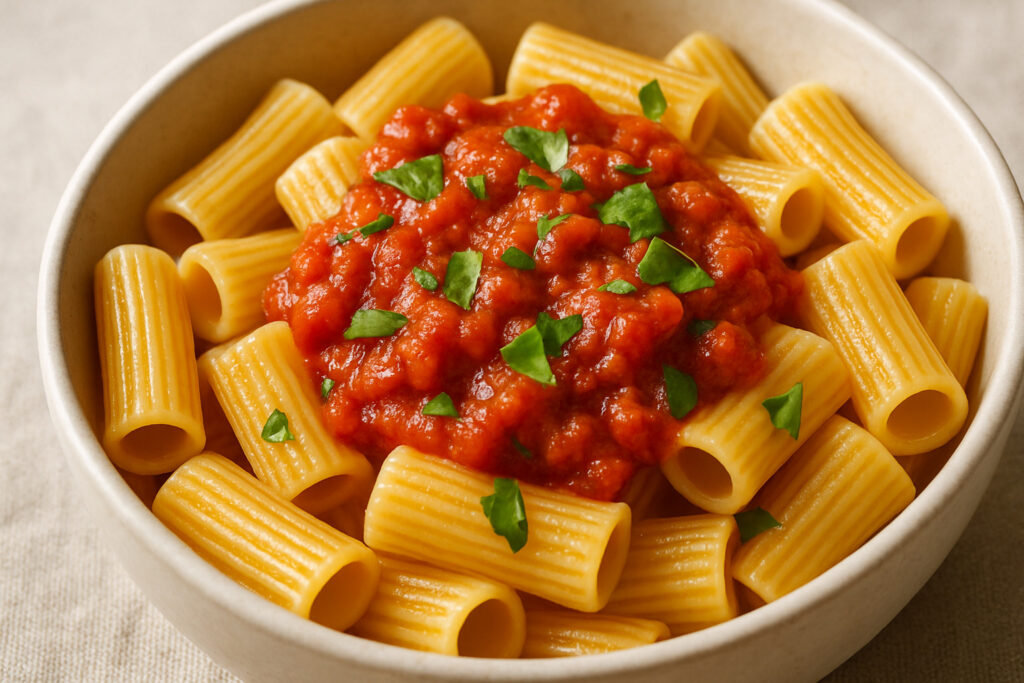






1 thought on “The Complete Guide to Rigatoni Pasta”
Pingback: A Comprehensive Guide to Bulgogi: Korean BBQ Explained - The Dining Destination
Comments are closed.